Wednesday, May 12, 2010
Participatory Video Validates Geo-Tagging Evidences on Mining Threats to Palawan Ecology and Indigenous Livelihoods
May 2010
Between July and September 2009, a mission organized by the Philippines-based Ancestral Land/Domain Watch (ALDAW) and the Centre for Biocultural Diversity (CBCD) at the University of Kent demonstrated how the ecological balance and the survival of vulnerable indigenous communities on Palawan Island (a “Man and Biosphere Reserve” program of UNESCO) is being threatened by the ongoing mining rush. The mission’s actual ‘matching’ of collected GPS data to photographs shows that the Mineral Production Sharing Agreements (MPSA) of mining firms, such as MacroAsia and Rio Tuba Nickel Mining Corporations, overlap with precious watersheds and the so called “core zones” of maximum protection. During the mission indigenous communities were engaged in the making and editing of participatory videos.
Today the voices of these isolated Palawan communities are available through the following links:
http://www.youtube.com/user/ALDAWpalawan
http://vimeo.com/aldawnetwork
Wednesday, April 28, 2010
ILO Convention on indigenous and tribal peoples: a manual
The manual - dated 2003 - does not explain each article of the Convention. It focuses on key concepts such as, for example, human rights, culture,land, development, education and health.
Nor does it strictly follow the structure of the Convention. It is divided into different sections. Each section deals with a key concept.
For easy reference, the manual has included the article or articles of the Convention which are being discussed. There is a descriptive explanation of each article. Concepts are introduced by using examples and experiences from indigenous and tribal peoples. This is to demonstrate the articles of the Convention in a practical way. ILO also included diagrams and photographs which highlight and explain some important elements of the articles.
Wednesday, April 21, 2010
Rethinking the Power of Maps
 A contemporary follow-up to the bestselling Power of Maps, this book takes a fresh look at what maps do, whose interests they serve, and how they can be used in surprising, creative, and radical ways.
A contemporary follow-up to the bestselling Power of Maps, this book takes a fresh look at what maps do, whose interests they serve, and how they can be used in surprising, creative, and radical ways.In Rethinking the Power of Maps, Denis Wood describes how cartography facilitated the rise of the modern state and how maps continue to embody and project the interests of their creators. He demystifies the hidden assumptions of map making and explores the promises and limitations of diverse counter-mapping practices today.
Thought-provoking illustrations include U.S. Geological Survey maps; electoral and transportation maps; and numerous examples of critical cartography, participatory GIS, and map art.
Wednesday, March 24, 2010
Power of Maps: (Counter) Mapping for Conservation
The authors argue that in doing so enriches consideration of the power geometries of conservation cartographies by inviting fuller consideration of diverse species and landscapes, as well as enabling discussion of other representational and productive effects of conservation mappings. Once determined, how might conservation maps serve to naturalize certain spaces or boundaries as fixed, or contribute to certain socio-psychological understandings of conservation possibilities or outcomes?
In the closing sections, the authors invoke the idea of ‘counter-mapping’ to explore strategies that might redress these concerns. Possibilities range from efforts to adapt the form of protected areas to more critical approaches that question the appropriateness of territorial focus and mapping practices for conservation goals.
In conclusion, Harris and Hazen argue that theorizing power in human, other-than-human, and inter-species contexts is essential to understanding the power geometries of conservation mapping.
Citation: Leila M. Harris and Helen D. Hazen, 2006. Power of Maps: (Counter) Mapping for Conservation. ACME: An International E-Journal for Critical Geographies, 4 (1), 99-130
Thursday, March 04, 2010
Geographic Information Technology and local spatial knowledge
Louis Liebenberg, founder and developer of CyberTracker technology shares his views on the importance of maintaining local knowledge at the forefront and to beware of the fact that technology may seduce users at the cost of dis-empowering local knowledge holders. Louis further highlights the role of the "Training Kit on Participatory Spatial Information Management and Communication" in empowering the grassroots.
Thursday, February 25, 2010
Palawan, Voices from the lost frontier
In March 2006, the Philippines’ President Gloria Macapagal-Arroyo has called for a revitalization of mining nation-wide. The future of Palawan, known as the Philippines’ “Last Frontier” is now under serious threat. The island was declared a “Man and Biosphere Reserve” by the UNESCO and it is also the home of vanishing and isolated indigenous communities. Despite the numerous policies and laws establishing the entire province as a protected area, Palawan is becoming one of the most attractive mining investments destinations. This documentary is the outcome of a joint effort of indigenous communities, farmers, local NGOs and international institutions.
Wednesday, February 24, 2010
Biocultural Diversity Conservation: A Global Sourcebook
 Biocultural Diversity Conservation:
Biocultural Diversity Conservation:A Global Sourcebook
By Luisa Maffi and Ellen Woodley
Publication date: 19th February 2010
'All of the world's cultures are utterly dependent upon the biodiversity among which they live. Each culture has developed ways of adapting to their biodiversity, drawing on nature for goods, services, inspiration, mythology, and much else besides. Biocultural Diversity Conservation is a treasure trove of the many approaches that have been taken by the world's diverse cultures to maintain the biological systems upon which they depend. This invaluable resource will certainly find great utility in all parts of the world and among many disciplines. '
Jeffrey A. McNeely, Senior Science Advisor, IUCN
'Here is a treasure trove of a book, one that will truly make a difference in the world. It represents a key milestone in our global understanding of the profound and inextricable links between cultural and biological diversity. Written by two of the leading lights in this new and growing field, it is filled with important information, case studies and analyses on a global scale.'
Nancy J. Turner, University of Victoria, Canada
'At long last: an authoritative guide to biocultural conservation. This is a splendid illumination of the intermingled diversity of culture and nature ... revealing and revolutionary.'
Thomas E. Lovejoy, Biodiversity Chair, The Heinz Center for Science, Economics and the Environment, USA
The field of biocultural diversity is emerging as a dynamic, integrative approach to understanding the links between nature and culture and the interrelationships between humans and the environment at scales from the global to the local. Its multifaceted contributions have ranged from theoretical elaborations, to mappings of the overlapping distributions of biological and cultural diversity, to the development of indicators as tools to measure, assess, and monitor the state and trends of biocultural diversity, to on-the-ground implementation in field projects.
This book is a unique compendium and analysis of projects from all around the world that take an integrated biocultural approach to sustaining cultures and biodiversity. The 45 projects reviewed exemplify a new focus in conservation: this is based on the emerging realization that protecting and restoring biodiversity and maintaining and revitalizing cultural diversity and cultural vitality are intimately, indeed inextricably, interrelated.
Tuesday, February 23, 2010
Ethics are central to community-based mapping processes
Dr. Nigel Crawhall, Director of Secretariat at the Indigenous Peoples of Africa Coordinating Committee (IPACC), a pan-African network, elaborates on the value of ethics in the context of participatory mapping processes.
More on practical ethics in PPGIS/PGIS practice is found here.
Sunday, February 21, 2010
Mapping the Sea - Improving Livelihoods
In 2005, when the Tsunami hit Banda Aceh in Indonesia, it killed many of the elderly fishermen. Much of the traditional knowledge about the waters surrounding Banda Aceh was lost with them. Traditionally this precious knowledge was transferred from generation to generation. In the post-Tsunami vacuum, this community-led initiative was able to retrieve and document some of that endangered knowledge.
This video documents the efforts done in one community, where traditional authorities coordinated the mapping of the coastal waters including the sea floor. So far 460 km of coastline have been mapped including previously unmapped features like four seamounts, four geologic faults and eighteen coral areas. In addition to the physical data, the community documented key biodiversity areas including shark nurseries, nesting beaches, spawning grounds. Data will be used to support the development of coastal resources and fisheries management plans.
According to Sumatra Konservasi Alam this project was completed at minimal cost (less than 10% of the cost of a conventional survey) and in less than one year. More information on the initiative is found at http://www.konservasi.org
Tuesday, February 16, 2010
Ogiek Indigenous Peoples Mapping their Lands
Julius Muchemi, Executive Director of ERMIS Africa, an NGO based in Kenya, reports on a Participatory 3D Modelling exercise which occurred in Nessuit, Kenya in August 2006. In the course of the exercise - attended by representatives from 21 Ogiek clans - an area of 52,800 ha was mapped at a scale 1:10,000. participants included close to 120 representatives from the different clans, men and women. Elders populated the model with their memories dating back to 1925 and reconstructed the landscape as it was at that time. The model displays 64 data layers including different types of areas, points and lines. In 2008 the Ogiek people expanded the coverage of the model to include further 40,000 ha.
Read more ...
Sunday, February 14, 2010
GIS for Emergency Preparedness and Health Risk Reduction
 Geographical Information Systems (GIS) have developed rapidly in recent years and now provide powerful tools for the capture, manipulation, integration, interrogation, modelling, analysis and visualisation of data -- tools that are already used for policy support in a wide range of areas at almost all geographic and administrative levels. This holds especially for emergency preparedness and health risk reduction, which are all essentially spatial problems. To date, however, many initiatives have remained disconnected and uncoordinated, leading to less powerful, less compatible and less widely implemented systems than might otherwise have been the case. The important matters discussed here include the probabilistic nature of most environmental hazards and the semi-random factors that influence interactions between these and human exposures; the effects of temporal and spatial scales on hazard assessment and imputed risk; the effects of measurement error in risk estimation and the stratification of risks and their impacts according to socioeconomic characteristics; and the quantification of socioeconomic differences in vulnerability and susceptibility to environmental hazards. GIS are powerful analytical tools in their own right, but what is needed is much more effective communication between the many disciplines, professions and stakeholders concerned -- something which this book helps to achieve.
Geographical Information Systems (GIS) have developed rapidly in recent years and now provide powerful tools for the capture, manipulation, integration, interrogation, modelling, analysis and visualisation of data -- tools that are already used for policy support in a wide range of areas at almost all geographic and administrative levels. This holds especially for emergency preparedness and health risk reduction, which are all essentially spatial problems. To date, however, many initiatives have remained disconnected and uncoordinated, leading to less powerful, less compatible and less widely implemented systems than might otherwise have been the case. The important matters discussed here include the probabilistic nature of most environmental hazards and the semi-random factors that influence interactions between these and human exposures; the effects of temporal and spatial scales on hazard assessment and imputed risk; the effects of measurement error in risk estimation and the stratification of risks and their impacts according to socioeconomic characteristics; and the quantification of socioeconomic differences in vulnerability and susceptibility to environmental hazards. GIS are powerful analytical tools in their own right, but what is needed is much more effective communication between the many disciplines, professions and stakeholders concerned -- something which this book helps to achieve.
Wednesday, February 10, 2010
Report on the situation of human rights and fundamental freedoms of indigenous peoples in Kenya
I am quoting part of the text and offer a link to the full document at the bottom of this post.
...
C. Hunter-gatherers and forest peoples
36. Settlement schemes, logging and charcoal production have put a severe strain on Kenya’s rich and varied forests, and have resulted in the loss of the traditional habitat of Kenya’s forest peoples, the indigenous hunter-gatherers such as the Awer (Boni), Ogiek, Sengwer, Watta, and Yaaku. While existing laws are oriented to the protection of wildlife and forest resources, many of these communities can no longer live by their traditional livelihoods, and their cultures and language are rapidly vanishing as a result; illegal logging has played a major role in this as well.
37. The way of life of the Ogiek is well adapted to the Mau Forest environment where they have lived for centuries. Numbering about 20,000 countrywide, they have been dispersed and assimilated in recent decades, and dispossessed of their traditional source of livelihood. When the Mau Forest was gazetted as a National Forest in 1974, the Ogiek were evicted from their traditional habitat without prior consultation or compensation, in violation of their basic human rights. They were henceforth prevented from hunting or collecting bee honey for survival in the forest, and were reduced to a miserable subsistence on the margins of this area rich in plants and wildlife. On the other hand, illegal logging, the introduction of exotic plantations and the excision of parts of the forest for private development by outside settlers have endangered the Mau Forest as a water catchment area, as well as the country’s environmental security. The Special Rapporteur on adequate housing, Miloon Kothari, signalled in his report on his mission to Kenya that the destruction of the forest has affected the rights of the Ogiek to housing, health, food and a safe environment, threatening to further destroy their cultural identity and the community as a whole (see E/CN.4/2005/48/Add.2, para. 61).
38. Despite a court injunction in their favour in 1997, the Government has proceeded to alienate Ogiek forest land, and a recent court decision does not recognize the Ogiek’s ancestral title to the forest. Still, the Government has distributed title deeds to land to several thousand Ogiek, and some non-Ogiek outsiders have tried to enrol as Ogieks in the hope that they may eventually also be given title deeds. The unresolved conflict between the Ogiek and their neighbours continues to this day. Being considered as squatters on their own land and legally banned from using the forest resources for their livelihood, their attempt to survive according to their traditional lifestyle and culture has often been criminalized and their repeated recourse to the courts has not been successful. Ogiek attribute this vulnerability to the fact that they are not recognized as a distinct tribe and therefore lack political representation. The Special Rapporteur met with members of several Ogiek villages, listened to their grievances and heard their demands for the recognition of their right to land and to maintain their traditional lifestyle in the forest.
...
90. In view of the above, the Special Rapporteur makes the following recommendations:
A. Recommendations to the Government
...
Forest areas
102. The rights of indigenous hunter-gatherer communities (particularly the Ogiek in Mau Forest) to occupy and use the resources in gazetted forest areas should be legally recognized and respected. Further excisions of gazetted forest areas and evictions of hunter-gatherers should be stopped. Titles derived from illegal excision or allocation of forest lands should be revoked, and new titles should only be granted to original inhabitants. Illegal commercial logging should be stopped.
C. Recommendations to indigenous communities and organizations
...
124. Indigenous peoples’ organizations are encouraged to develop concrete strategies for data collection, research and documentation to support their advocacy work both at the national and international levels.
D. Recommendations to civil society and political parties
...
127. NGOs and donors should strengthen their relations with indigenous communities, support their development initiatives and promote a better understanding of their demands and aspirations within Kenyan society.
...
Read / download the full document.
Monday, February 08, 2010
Knowledge and cultural transmission in Kenyan participatory mapping
In this 5 minute interview Dr. Nigel Crawhall, Director of Secretariat at IPACC, elaborates on intergenerational ecological knowledge transmission in Participatory 3-dimensional modelling (P3DM). Crawhall discusses his observations on intergenerational interaction when the Ogiek community of Nessuit, Kenya built a geo-referenced model of their mountain forest landscape in 2006.
Sunday, February 07, 2010
Geographic Information Science and Public Participation
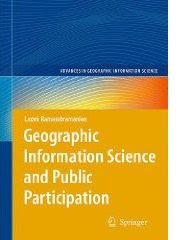 Computer-mediated participation is at the crossroads. In the early heady days of the digital revolution, access to "high" technologies such as GIS promised the empowerment of marginalized communities by providing data and information that was previously hidden away from public view. To a great extent, this goal has been achieved at least in the U.S. and Western Europe – data about a range of government initiatives and raw data about different aspects of spatial planning such as land use, community facilities, property ownership are available a mouse-click away. Now, that the public, have access to information, are we able to make better plans for the future of our cities and regions? Are we more inclusive in our planning efforts? Are we able to foster collaborative governance structures mediated by digital technologies?
Computer-mediated participation is at the crossroads. In the early heady days of the digital revolution, access to "high" technologies such as GIS promised the empowerment of marginalized communities by providing data and information that was previously hidden away from public view. To a great extent, this goal has been achieved at least in the U.S. and Western Europe – data about a range of government initiatives and raw data about different aspects of spatial planning such as land use, community facilities, property ownership are available a mouse-click away. Now, that the public, have access to information, are we able to make better plans for the future of our cities and regions? Are we more inclusive in our planning efforts? Are we able to foster collaborative governance structures mediated by digital technologies?In Geographic Information Science and Public Participation (Advances in Geographic Information Science)
The foreword for the book is written by Prof. Bill Huxhold.
Tuesday, February 02, 2010
Digital Cartography
Digital Cartography from dynamicmediainstitute.org on Vimeo.
By Andrew Ellis, Alexander Wang, Students at the Dynamic Media Institute, Massachusetts College of Art and Design
Digital Cartography is a short documentary film on the transition of maps into their digital form. In this film we speak with programmer and mapmaker Jeffrey Warren from the MIT Media Lab and Dietmar Offenhuber from SENSEable City Lab at MIT. We explore the cultural, economic and technical aspects of mapmaking and how they affect the way we communicate with one another.
In our interviews with Jeffrey and Dietmar we learn about the social and geographical ramifications of building maps and how designers can implement their literacy in communication design to explore different avenues for mapping. Participatory mapping such as Open Street Maps and psychogeography and the virtual dérive are some of the themes discussed around the history and future of mapping in the digital age. Jeffrey gives us a demonstration on low cost arial photography using a helium balloon and a consumer digital camera to stitch photos onto google maps.
Metodología participativa para construir una maqueta 3D en Telpaneca, Nicaragua
El video es una producción de la Unión Nacional de Agricultores y Ganaderos (UNAG) de Nueva Segovia, y la ONG francesa Agrónomos y Veterinarios Sin Fronteras (AVSF).
Monday, February 01, 2010
Community Mapping in Tsunami Affected Areas in Aceh, Indonesia
The documentary has been jointly produced by the Indonesia Community Mapping Network or Jaringan Kerja Pemetaan Partisipatif (JKPP), and the Center for people Economic Development or Yayasan Rumpun Bambu Indonesia (YRBI).
More videos on participatory mapping are found here.
Sunday, January 31, 2010
CyberTracker releases a sample database for Disaster Relief Rapid Surveying
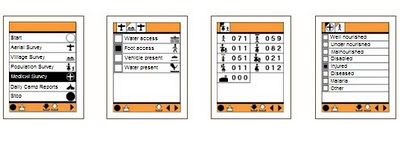 The CyberTracker software can be installed on GPS-enabled Windows Mobile smartphones.
The CyberTracker software can be installed on GPS-enabled Windows Mobile smartphones.This may help to gather crucial data required to co-ordinate disaster relief logistics.
One of the critical problems in disaster relief management is the lack of reliable data on basic needs on the ground after a major natural disaster. Disaster relief efforts must overcome serious logistical problems due to poor communication and unreliable information. Gathering good quality data on the ground will make it possible to make informed decisions on where the highest priorities are.
Better information on quantities of relief supplies needed, such as medicines, food, blankets, shelter and clothing will ensure that resources are used more efficiently where they are needed most.
Source: Louis Liebenberg, CyberTracker Conservation
Saturday, January 30, 2010
Indigenous People’s Exchanges Amongst Philippines and Peru Promoted by CBCD and ALDAW
 The establishment of this linkage took place right at the time when indigenous peoples of the Amazonian Peru had began various forms of open resistance against hydrocarbon extraction in their traditional territories. The solidarity link between the IPs of Peru and Palawan is being consolidated through the collaboration of the Ancestral Land/Domain Watch (ALDAW), the Peoples and Plants International (PPI) and, specifically, through the personal efforts of Dr. Miguel Alexiades (CBCD staff and PPI co-director). Such exchange promotes the sharing of experiences as a way of 1) fostering reflection and joint actions through the establishment of strategic alliances; and 2) addressing common problems regarding indigenous links, rights and claims over ancestral homelands and cultural landscapes.
The establishment of this linkage took place right at the time when indigenous peoples of the Amazonian Peru had began various forms of open resistance against hydrocarbon extraction in their traditional territories. The solidarity link between the IPs of Peru and Palawan is being consolidated through the collaboration of the Ancestral Land/Domain Watch (ALDAW), the Peoples and Plants International (PPI) and, specifically, through the personal efforts of Dr. Miguel Alexiades (CBCD staff and PPI co-director). Such exchange promotes the sharing of experiences as a way of 1) fostering reflection and joint actions through the establishment of strategic alliances; and 2) addressing common problems regarding indigenous links, rights and claims over ancestral homelands and cultural landscapes. The envisaged goal is to enable the production of jointly produced video materials that could be used to exert pressure at a national and international policy level.
The envisaged goal is to enable the production of jointly produced video materials that could be used to exert pressure at a national and international policy level.Julio Cusurichi, representing the indigenous organization COINBAMAD (Consejo Indigena de la Cuenca Baja de Madre De Dios) and winner of the well-known award, the Goldman Prize - arrived in the Philippines on July 2009, leaving the country after 21 days. He traveled to Palawan (Philippines) accompanied by Dr. Novellino and the ALDAW (Ancestral Domain/Land Watch) staff. In Palawan, local indigenous organizations (Bangsa Palawan Philippines and NATRIPAL) facilitated the dialogue between Julio and different Palawan communities, while Dr. Novellino helped in the simultaneous translation from Spanish to Palawan language. During his stay, Julio met many indigenous leaders and communities’ members (including women and children) and shared his experience and lessons regarding the impacts of mining and other forms of commercial extractivism upon cultural landscapes and ancestral homelands. Participatory videos showing the impact of mining and oil extraction in Madre de Dios (Peru) have been shown also to the most isolated Palawan communities.
Through Julio’s visit, a process of direct exchange between grassroots indigenous mobilization in Madre de Dios, Peru and local indigenous anti-mining movements in Palawan has been initiated. Before Julio’s departure, this collaboration has been formalized in a Memorandum of Understanding. Video shootings made by Julio Cusurichi in Palawan have been taken back to Peru and will be shown to the Amazonian indigenous communities. A cross-visit of Palawan representatives to the Peruvian Amazon has been planned for the year 2010.
Saturday, January 23, 2010
Counter-mapping in the Philippines: The Gantong Geo-Tagged Report
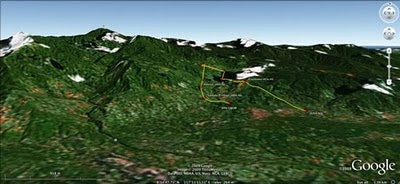 The mission’s actual ‘matching’ of collected GPS data to photographs shows that the Mineral Production Sharing Agreements (MPSA) of two mining firms [MacroAsia and Celestial Nickel Mining and Exploration Corporation (CNMEC) now operated by Ipilan Nickel Corporation (INC)] overlap with precious watersheds endowed with numerous creeks, springs and waterfalls providing potable water to the local indigenous communities and lowland farmers. More importantly, under the ECAN Guidelines of the Strategic Environmental Plan for Palawan (Republic Act 7611), such areas constitute the so called “core zones” of maximum protection where industrial extractive activities are not allowed.
The mission’s actual ‘matching’ of collected GPS data to photographs shows that the Mineral Production Sharing Agreements (MPSA) of two mining firms [MacroAsia and Celestial Nickel Mining and Exploration Corporation (CNMEC) now operated by Ipilan Nickel Corporation (INC)] overlap with precious watersheds endowed with numerous creeks, springs and waterfalls providing potable water to the local indigenous communities and lowland farmers. More importantly, under the ECAN Guidelines of the Strategic Environmental Plan for Palawan (Republic Act 7611), such areas constitute the so called “core zones” of maximum protection where industrial extractive activities are not allowed.At an altitude of about 500m ASL the mission reached indigenous settlements inhabited by very traditional Palawan having limited contacts with the outside. Their sustenance totally depends on the available forest resources, and it consists of a heterogeneous economy where sustainable swidden cultivation is integrated with foraging and the collection of non-timber forest products (NTFPs).
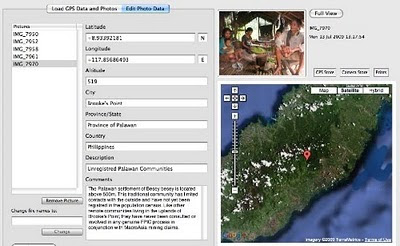
Overall, the mission moved from an elevation of a few meters ASL to an altitude of about 670m ASL, where one of the furthermost Palawan settlements is located. The mission’s GPS coordinates were obtained through the use of the JOBO GPS device being connected to the camera’s hot shoe. Positions were taken at intervals of several meters in order to reconstruct the mission’s full itinerary. The geo-tagged images were then loaded into ‘Photo GPS Editor’ and displayed on satellite Google map. All upland Palawan interviewed during the ALDAW/CBCD mission have declared that they have never been consulted about the entrance of mining companies in their traditional territories.
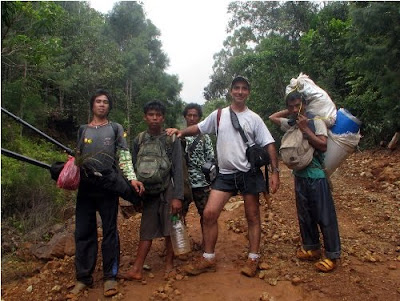
According to indigenous representatives, the Palawan branch of the National Commission on Indigenous Peoples (NCIP) – the government body mandated to ‘protect and promote the interest and well-being of cultural communities’ – is now siding with the mining companies. It is hoped that the ALDAW/CBCD Gantong geo-tagged report will facilitate the circulation of information, at both the national and international levels, on the threats faced by ‘irresponsible mining’ in the Philippines’ “last frontier”. An international campaign to support indigenous Palawan claims to their ancestral land has also been initiated by Survival International.
Source: The ALDAW NETWORK
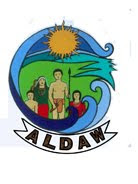
The ALDAW NETWORK (Ancestral Land/Domain Watch) is an advocacy-campaign network of Indigenous Peoples jointly constituted by NATRIPAL (United Tribes of Palawan) and BANGSA PALAWAN PHILIPPINES (Indigenous Alliance for Equity and Wellbeing) on August 2009.
